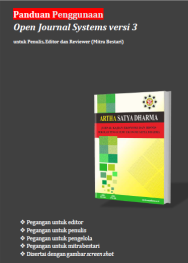Tourism Experience Design dan Penciptaan Nilai Pelanggan Pada Pariwisata di Bali
Abstract
Tourism industry is the most important economic activities in Bali. Generally high and low levels of economy in Bali is reflected in the tourism industry. Tourism industry in Bali are required to improve in order to create value added for customers. The increase of domestic and foreign tourists is not followed by the increase of the hotel occupancy rate in Bali. Not only giving satisfaction to customers through a visual experience but also an emotional experience should be a concern. Tourist experience can be a positive experience if their expectations when visiting are fulfilled, viceversa the tourist experience can be negative if the tourist expectations when visiting are not fulfilled. The aim of this paper is to describe a role off tourism experience design to create customer value, especially in Bali. The diverse of Balinese culture can be an opportunity to create variety of a product. The method used is qualitative descriptive with literature approach. This research describe a role model of product development experience by combining the concepts of design and culture to create value added for consumers. The products produced by considering aspects of the experience that is created and cultural variations in each area in Bali. The existence of the variety of products and a touch of different cultures can create variations of value added for customers.
Downloads
References
Baker, J., Grewal, D., and Parasuraman, A. 1994. The influence of store environment on quality inferences and store image. Journal of the Academy of Marketing Science. DOI: 10.1177/0092070394224002
Berry, L. L., E. A. Wall, and L. P. Carbone (2006). “Service Clues and Customer Assessment of the Service Experience: Lessons from Marketing.” Academy of Management Perspectives.
Binkhorst, Esther. 2006. The Co-Creation Tourism Experience. http://www.esade.edu/cedit2006/pdfs2006/papers/esther_binkhorst_paper_esade_may_06.pdf
Bitner, M. J., B. H. Boons, and M. S. Tetreault (1990). “The Service Encounter: Diagnosing Favorable and Unfavorable Incidents.” Journal of Marketing.
Carbone, L. P. and S. H. Haeckel (1994). “Engineering Customer Experiences.” Journal of Marketing Management.
Clark, G., R. Johnston, and M. Shulver (2000). “Exploiting the Service Concept for Service Design and Development.” In Fitzsimmons, J. and M. Fitzsimmons (Eds.), New Service Design (pp. 71–91). Thousand Oaks, CA: Sage.
Desmet, P. M. A., and Hekkert, P. 2007. Framework of product experience. International Journal of Design. https://www.researchgate.net/publication/ 235700959_Framework_of_Product_Experience.
Desmet, P. M. A., Hekkert, P., and Jacobs, J. J. 2000. When a car makes you smile: development and application of an instrument to measure product emotions. https://www.researchgate.net/publication/248426937_When_a_car_makes_you_smile_Development_and_application_of_an_instrument_to_measure_product_emotions
Edvardsson, B., Olsson, J., 1996. Key concepts for new service development. The Service Industries Journal.
Edvardsson, B., A. Gustavsson, M. D. Johnson, and B. Sandén (2000). New Service Development and Innovation in the New Economy. Lund, Sweden: Studentlitteratur.
Forder, Claire. 2015. Exploring Customer Value in the Experience Economy Service Encounter – An Exploratory Study. http://www.reser.net/materiali/priloge/slo/ forder_exploring-customer-value-in-the-experience-economy-service-encounter--an-exploratory-study.pdf
Goldstein, S.M., R. Johnston, J. Duffy, and J. Rao (2002). “The Service Concept: The Missing Link in Service Design Research?” Journal of Operations Management.
Grönroos, C. 1984. A service quality model and its marketing implications. European Journal of Marketing, https://www.researchgate.net/publication/ 233522386_A_Service_Quality_Model_and_Its_Marketing_Implications
Grönroos, C., and Voima, P. 2012. Critical service logic: making sense of value creation and co-creation. Journal of the Academy of Marketing Science, 41(2), 133–150. doi:10.1007/s11747-012-0308-3.
Gunn, C. A. (2002). Tourism Planning: Basics, Concepts, Cases. Fourth Edition. New York: Routledge.
Holmlid, S. and S. Evenson (2008). “Bringing Service Design to Service Sciences, Management and Engineering.” In Hefley, B. and W. Murphy (Eds.), Service Science, Management and Engineering Education for the 21st Century (pp. 341-345). Norwell, MA: Springer.
Heide, M., K. Lærdal, and K. Grønhaug, K. (2007). ”Atmosphere as a Tool for Enhancing Organizational Performance: An Exploratory Study from the Hospitality Industry.” European Journal of Marketing,
Kotler, P., Keller, K. L., Brady, M. K., Goodman, M., Hansen, T. 2009. Marketing management. Pearson Education: Harlow.
Komppula, Raija. 2005. Pursuing Customer Value In Tourism : A Rural Tourism Case Study.: https://www.researchgate.net/publication/228428540
Liu, D.-R., M. Shen, and C.-T. Liao (2003). “Designing a Composite e-Service Platform with Recommendation Function.” Computer Standards and Interfaces.
Lee, G., I. P. Tussyadiah, and F. Zach (2010). “A Visitor-Focused Assessment of New Product Launch: The Case of Quilt Gardens TourSM in Northern Indiana’s Amish Country.” Journal of Travel & Tourism Marketing.
Love, T. (2002). “Constructing a Coherent Cross-Disciplinary Body of Theory about Designing and Designs: Some Philosophical Issues.” Design Studies.
Lumsdon, L. M. (2006). “Factors Affecting the Design of Tourism Bus Services.” Annals of Tourism Research.
Middleton, V.T.C. & Clarke, J. 2001. Marketing in Travel and Tourism. 3rd Edition. Oxford: Butterworth-Heinemann.
Murphy, P., Pritchard, M.P. & Smith, B. 2000. The Destination product and its impact on traveler perceptions. Tourism Management
Moalosi, Richie and Popovic, Vesna and Hickling-Hudson, Anne R. 2007. Culture-orientated Product Design. https://www.sd.polyu.edu.hk/iasdr/proceeding/papers/culture-orientated%20product%20design.pdf.
Normann, R. (1991). Service Management: Strategy and Leadership in Service Business. New York: Wiley.
Parasuraman, A. (1997). “Reflections on Gaining Competitive Advantage Through Customer Value.” Academy of Marketing Science Journal.
Prahalad, C. K., & Ramaswamy, V. 2004. Co-creation experiences: The next practice in value creation. Journal of Interactive Marketing. doi:10.1002/dir.20015
Pine, B., & Gilmore, J. 1998. Welcome to the experience economy. Harvard Business Review
Press, M., & Cooper, R. 2003. The design experience: The role of design and designers in the twenty-first century. https://www.researchgate.net/publication/ 235700729_The_Design_Experience_The_Role_of_Design_and_Designers_in_the_Twenty-First_Century
Rihova, Ivana. Buhalis, Dimitrios. Moital, Miguel. Gouthro, Mary-Beth. 2014. Conceptualising Customer-to-customer Value Co-creation in Tourism : International Journal of Tourism Research. http://eprints.bournemouth.ac.uk/21219/ 1/IJTR%20resubmission%20final.pdf
Ruiz , D. Martín. Castro C. Barroso. Díaz, I. M. Rosa. 2012. Creating Customer Value Through Service Experiences: An Empirical Study In The Hotel Industry. https://papers.ssrn.com/sol3/Delivery.cfm?abstractid=2093355.
Scott, Noel and Ding, Peiyi. 2013. Tourism Experience Design: Some Recent Research. http://www.lyxk.com.cn/EN/10.3969/j.issn.1002-5006.2013.01.001.
Sheth, J. N., Newman, B. I., & Gross, B. L. 1991. Why we buy what we buy: a theory of consumption values. Journal of Business Research. https://www.researchgate.net/ publication/4965989_Why_We_Buy_What_We_Buy_A_Theory_of_Consumption_Values.
Smith, S.L.J. 1994. The Tourism Product. Annals of Tourism Research Vol. 21.
Shostack, G.L. (1982). “How to Design a Service.” European Journal of Marketing.
Shostack G.L. (1984). “Designing Services that Deliver.” Harvard Business Review.
Stickdorn, M. and J. Schneider (2010). This is Service Design Thinking. Amsterdam: BIS Publishers.
Stickdorn, M. and B. Frischhut (2012). Service Design and Tourism: Case Studies of Applied Research Projects on Mobile Ethnography for Tourism Destinations. Books on Demand.
Stickdorn, M. and A. Zehrer (2009). “Service Design in Tourism: Customer Experience Driven Destination Management.” In Proceedings of the First Nordic Conference on Service Design and Service Innovation.
Strannegård, L. and M. Strannegård (2012). “Works of Art: Aesthetic Ambitions in Design Hotels.” Annals of Tourism Research
Trischler, J. and A. Zehrer (2012). “Service Design: Suggesting a Qualitative Multi-step Approach for Analyzing and Examining Theme Park Experiences.” Journal of Vacation Marketing.
Tscaur, S-H., Chiu, Y-T., & Wang C-H. 2006. The Visitors Behavioral Consequences of Experiential Marketing: An Empirical Study on Taipei Zoo. doi:10.1300/J073v21n01_04
Tussyadiah, I., D. R. Fesenmaier, and Y. Yoo (2008). “Designing Interactions in Tourism Mediascape: Identification of Patterns for Mobile 2.0 Platform.” In O’Connor, P., Hopken, W. Gretzel, U. (Eds.), Information and Communication Technologies in Tourism 2008. Vienna - New York: Springer.
Williams, A.P. and Soutar, G. 2000. Dimensions of Customer Value and the Tourism Experience: An Exploratory Study. http://anzmac.org/conference_archive/2000/ CDsite/papers/w/William3.PDF.
Zátori, Anita. 2013 Tourism Experience Creation From. A Business Perspective. PH.D. THESIS. phd.lib.uni-corvinus.hu/801/7/Zatori_Anita_den.pdf.


